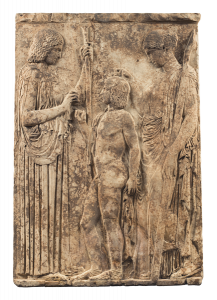By Justin Clement
One of the things that makes the Big Eleusinian Relief so interesting is the fact that it is indeed so very big. 220cm tall and 152cm wide, the Big Eleusinian Relief is huge. Carved from the characteristic yellow marble of Mount Pentelicus and dating to 440-430 BCE, the Big Eleusinian Relief was famous even in antiquity. At least one Roman copy survives at the Met, dating from the early Imperial period.
The Relief itself depicts the chief deities of the Eleusinian Mysteries cult, Demeter and Kore, blessing a naked male youth identified as Triptolemus, son of the king of Eleusis, Keleos. The two goddesses stand on either side of the much smaller boy, Demeter on the left and Kore (also known as Persephone) on the right. Notice how Triptolemus clutches at the hem of Kore’s robe, almost as if he’s terrified. Demeter holds a kind of ritual scepter and appears to be handing something to Triptolemus; whatever it might have been is impossible to say, although if the youth is indeed Triptolemus, an ear of grain would be a fair guess, especially considering what we know about the Eleusinian Mysteries. Triptolemus was said to have been taught the secret of agriculture by Demeter, a gift which he then spread across the globe in a winged chariot.
Unfortunately, what we know about the Mysteries isn’t much; initiates–which included most, if not all, Athenians–were forbidden from recording or revealing the rituals that went on at Eleusis under pain of death. The Athenians took the Mysteries very, very seriously. So seriously, in fact, that the mere rumour of a blasphemous ritual mocking the Mysteries having been performed by unidentified young men in 415 BCE caused so much public outrage that a reward was offered to anyone who came forward with information. Even slaves were offered this reward, which was indeed a strange occurrence, since their word was otherwise inadmissible in court without the use of torture to obtain a confession (even when acting as witnesses). Alcibiades, the general leading Athens’ forces on the (soon to be) disastrous Sicilian Expedition, was implicated in the blasphemy by his political rivals, sentenced to death in absentia, and ordered to return to Athens to face his punishment. What made the Mysteries important enough to justify pulling a general from his fleet mid-campaign? What secrets did the initiated learn?
Hippolytus of Rome, a 3rd century AD theologian, wrote in his Refutation of All Heresies, that the initiates are shown nothing more than a “green ear of grain reaped,” which is supposed to represent the eternal life promised by the Mysteries cult. This is the big secret (according to Hippolytus); corroborating the myth told in the Homeric Hymn to Demeter, the Mysteries provide an escape from the depressing gloom of the Greek underworld through the ascent of Kore from Hades to Olympos. The ear of grain, the symbol of Demeter, represents the growth of springtime vegetation associated with Kore’s return from the land of the dead. This sacred grain and this secret myth (or rather, the understanding of the myth as a promise of protection in the afterlife), were all hidden from outsiders, and, despite the cult’s popularity (remember, the Romans bothered to copy the Big Eleusinian Relief), were never recorded by any true believers.
There is some debate over just what function the Relief might have served. Was it a votive offering? Was it a cult image? As a cult image, the Big Relief (an appropriate name, given the protection the cult offered to the initiated) would have been kept at the sanctuary of Eleusis and used to help explain the myths as well as glorify the goddesses. Votives were offerings presented by individuals for guidance/divine favour, or (as was usual in Greece) in exchange for some specific request (especially curse tablets). The expense and size of the Big Eleusinian Relief, the fact that it was copied some 400 years after its creation by the Romans, and the possibility that it depicts a scene strongly associated with the cult’s secrets, suggest that it was not a votive, but rather had cult significance. This is not the kind of thing you’re likely to lug to the temple in exchange for a favour. I hope to get a better look at the objects the goddesses are holding in their left hands, and what they might have been holding in their right.
If you’re interested in learning more about the Big Eleusinian Relief, here’s a bibliography.
Works Cited
Hippolytus’ Refutation of All Heresies, Book V:
http://www.newadvent.org/fathers/050105.htm
Gisela M. A. Richter. “A Roman Copy of the Eleusinian Relief.” The Metropolitan
Museum of Art Bulletin, vol. 30, no. 11, 1935, pp. 216–221. JSTOR,
www.jstor.org/stable/3255443.
The official Met page for the Roman copy:
http://www.metmuseum.org/toah/works-of-art/14.130.9/
The official National Museum page for the original:
http://www.namuseum.gr/collections/sculpture/classical/classic06-en.html




